Parastrata
for Pierrot Ensemble
9,50 €
Versión digital (+0,00 €) para descarga
Versión impresa (+16,20 € impresión y envío). Colissimo7-14 days aprox.
Al comprar una partitura, usted puede contactar al compositor aquí mismo!
Especificaciones
Region
North America (Canada - USA)
Estimated Duration
6 - 10min
Date
2017
ISMN : 979-0-2325-4667-4
Videos alrededor de ésta pieza
Descripción Parastrata is inspired by both philosophy and mathematics; in this note I will go into some technical detail. Two concepts of Gilles Deleuze and Felix Guattari are especially important for this work: the opposition of smooth vs. striated spaces; and the related idea of three strata, substrata-parastrata-epistrata. These concepts constitute the vertebrae of Deluezian philosophy, explaining his well-known “difference and repetition” processes, which eventually generate a “becoming” of all the epistemological meanings / beings in this world. In Deleuzian philosophy, the real world doesn’t exist as a reflection of an ideal world (or symbolic representations of imaginary orders, in Lacan’s words), but simply exists as progressive forms of infinite variations of simulacra; true beings, or “becomings” exist in between slight variations from duplication-reproduction processes. Deleuze named the fundamental layer (stratum) of these reproduction-loops as substrata, the surface level as epistrata, and the central transmuting/mitigating interfaces of nexus as parastrata.
"A stratum exists only in its epistrata and parastrata, so that in the final analysis these must be considered strata in their own right. The ideally continuous belt or ring of the stratum—the Ecumenon defined by the identity of molecular materials, substantial elements, and formal relations—exists only as shattered, fragmented into epistrata and parastrata that imply concrete machines and their respective indexes, and constitute different molecules, specific substances, and irreducible forms. (Gilles Deleuze and Felix Guattari, A Thousand Plateaus: Capitalism and Schizophrenia (London: Continuum, 1987), 52.)"
Smooth space is another concept which reinforces these ideas:
"It is a space constructed by local operations involving changes in direction. These changes in direction may be due to the nature of the journey itself, as with the nomads of the archipelagoes (a case of “directed” smooth space); but it is more likely to be due to the variability of the goal or point to be attained… smooth space is directional rather than dimensional or metric. Smooth space is filled by events or haecceities, far more than by formed and perceived things. It is a space of affects, more than one of properties. …It is an intensive rather than extensive space, one of distances, not of measures and properties. Intense Spatium instead of Extensio. (Ibid., 478.)"
The fundamental compositional tool I initiated to represent this idea (or the concept which smoothly emerged while I was struggling), is an image of gradually changing harmonic / timbral colors generated by frequency modulation (FM) formula. By employing FM formula and adopting elementary number theory, I could play with harmonic space by saturating it with a thousand different sonic colors with common / differentiated virtual fundamental tones. Rather than juxtaposing indifferent harmonies with no hierarchical context, each consecutive harmony is organically intertwined, sharing a certain portion of timbral structure. As the music evolves, the virtual fundamental evaporates or precipitates.
Add to list
- Login to create your own lists
"A stratum exists only in its epistrata and parastrata, so that in the final analysis these must be considered strata in their own right. The ideally continuous belt or ring of the stratum—the Ecumenon defined by the identity of molecular materials, substantial elements, and formal relations—exists only as shattered, fragmented into epistrata and parastrata that imply concrete machines and their respective indexes, and constitute different molecules, specific substances, and irreducible forms. (Gilles Deleuze and Felix Guattari, A Thousand Plateaus: Capitalism and Schizophrenia (London: Continuum, 1987), 52.)"
Smooth space is another concept which reinforces these ideas:
"It is a space constructed by local operations involving changes in direction. These changes in direction may be due to the nature of the journey itself, as with the nomads of the archipelagoes (a case of “directed” smooth space); but it is more likely to be due to the variability of the goal or point to be attained… smooth space is directional rather than dimensional or metric. Smooth space is filled by events or haecceities, far more than by formed and perceived things. It is a space of affects, more than one of properties. …It is an intensive rather than extensive space, one of distances, not of measures and properties. Intense Spatium instead of Extensio. (Ibid., 478.)"
The fundamental compositional tool I initiated to represent this idea (or the concept which smoothly emerged while I was struggling), is an image of gradually changing harmonic / timbral colors generated by frequency modulation (FM) formula. By employing FM formula and adopting elementary number theory, I could play with harmonic space by saturating it with a thousand different sonic colors with common / differentiated virtual fundamental tones. Rather than juxtaposing indifferent harmonies with no hierarchical context, each consecutive harmony is organically intertwined, sharing a certain portion of timbral structure. As the music evolves, the virtual fundamental evaporates or precipitates.
Instrumentation
Flute|Clarinet|Piano|Violin|Cello
Recording
2017 Conference Ensemble at Wellesley College
James Baker
James Baker
Score Details
Format - Undefined
Pages - 40
Pages - 40




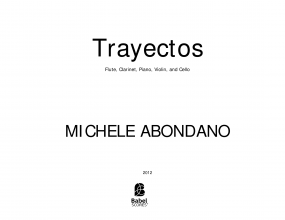
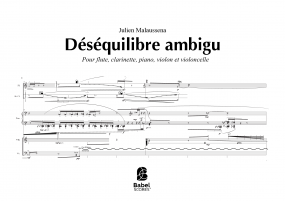

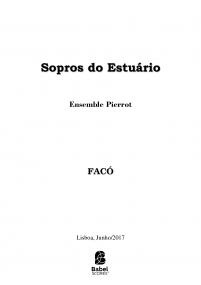
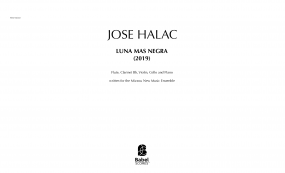
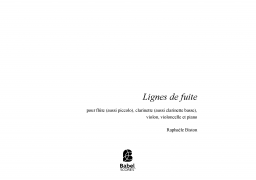
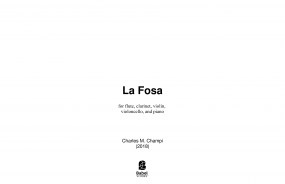
a4 z_285x285.png)

